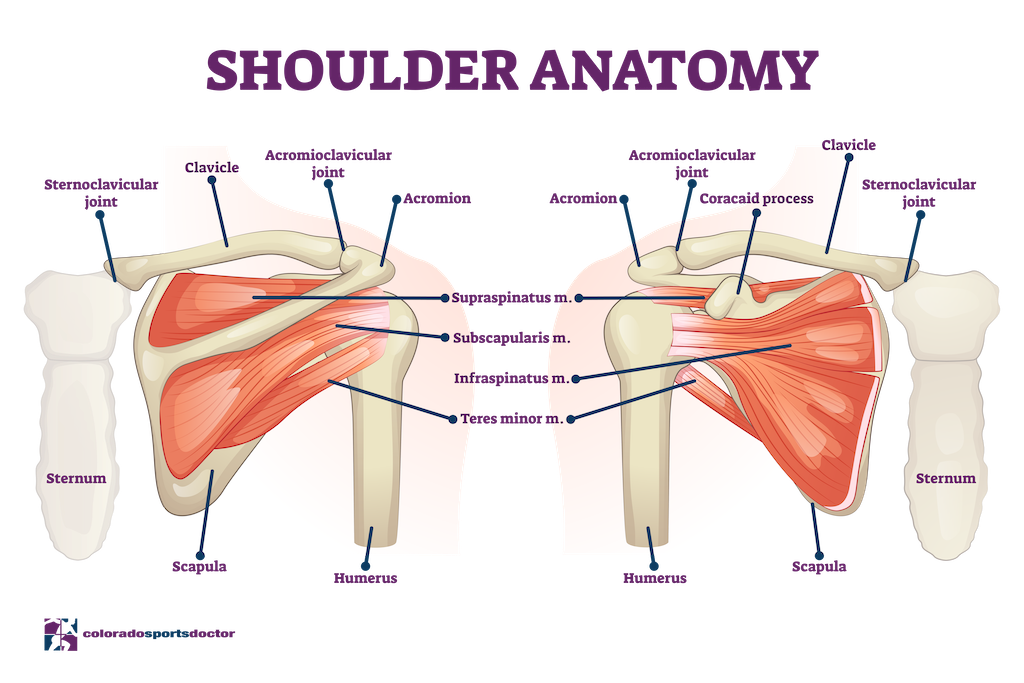Shoulder pain can be concerning, and some symptoms are unmistakable warnings. This post provides an essential guide for identifying the red flags for shoulder pain — including persistent discomfort, acute weakness, or systemic symptoms like fever — that demand prompt medical attention.
Key Takeaways
- Persistent, worsening, or acute shoulder pain; weakness, immobility, and systemic symptoms like fever are red flags that necessitate urgent medical attention.
- Various conditions such as rotator cuff injuries, arthritis, shoulder dislocations, and referred neck pain are leading causes of shoulder discomfort, each presenting with distinct symptoms and requiring specific treatments.
- Preventing shoulder pain involves lifestyle adjustments like good posture and ergonomics, proper body mechanics, and regular exercises to maintain muscle strength and joint flexibility.
Understanding Shoulder Pain
Anyone, regardless of age, fitness level, or lifestyle, can experience shoulder pain and can learn how to identify the red flags of shoulder pain. It can be a mere annoyance or a debilitating condition that hampers daily activities. Shoulder pain can stem from a variety of causes, often linked to overuse, wear and tear, and injury. One might even experience a common phenomenon known as shoulder impingement, which involves the pinching of soft tissues and is often associated with activities or damage leading to compression in the shoulder region.
Identifying the Red Flags of Shoulder Pain
There are numerous specific conditions that contribute to shoulder pain. The manifestation of shoulder pain can vary as well. Some may experience a sharp or dull ache, a burning sensation, or even tingling, with the intensity fluctuating according to the underlying cause.
Let’s delve deeper into some specific shoulder pain causes, starting with rotator cuff disorders, such as rotator cuff injuries.
Rotator Cuff Injuries
Rotator cuff injuries, which are quite common, often cause shoulder pain. These injuries can lead to discomfort and limited range of motion in the shoulder. They encompass a range of conditions, from early tendon degeneration to complete rotator cuff tears, commonly caused by inflammation or damage to tendons, often related to impingement in the subacromial space. If you’ve been noticing swelling, soreness, and pain in your shoulder, especially when lying down, these could be symptoms of a rotator cuff injury, possibly indicating a full tear.
What’s more alarming is an acute rotator cuff tear due to trauma. This is a red flag that necessitates urgent medical referral as potential surgical intervention might be required. For severe, irreparable rotator cuff tears, there are treatment options available, such as a minimally invasive procedure using a subacromial balloon spacer to stabilize the joint.
Another potential cause of shoulder pain to consider is arthritis, which may sometimes be confused with a frozen shoulder.
Shoulder Arthritis
Arthritis of the shoulder is another common culprit behind persistent shoulder discomfort. It can make simple tasks such as reaching for an item on a high shelf or even brushing your hair a challenge. The pain, stiffness, and reduced mobility it brings often result from wear and tear or injury.
While arthritis is more common in older adults, it can strike at any age, particularly if you have a history of shoulder injuries. Recognizing the early symptoms of arthritis, such as joint pain, stiffness, or swelling, can help you seek timely medical attention and manage your condition effectively. However, the shoulder can also be a victim of another kind of mishap—dislocations.
Anatomy of the Shoulder Joint

The shoulder joint, also known as the ball and socket joint, is a complex structure comprised of three bones: the scapula (shoulder blade), clavicle (collarbone), and humerus (upper arm bone). The glenohumeral joint, a ball-and-socket synovial joint, allows for a wide range of motion but is prone to instability and dislocation due to its structure. This joint complex includes several other joints and is facilitated by muscles, including the rotator cuff and deltoid, which play a crucial role in shoulder movement and stability.
Grasping the intricacies of anatomic total shoulder replacement surgeries hinges on understanding this anatomy.
Pre-Surgery Preparation: What to Expect
Prior to surgery, a few steps can help you prepare for a successful outcome. Here are some things you can do to prepare:
- Optimize your health by eating a balanced diet, exercising regularly, and getting enough rest.
- Schedule any necessary preadmission testing, such as blood work or imaging scans.
- Arrange transportation to and from the hospital on the day of surgery.
- Make arrangements for in-home care, if needed, during your recovery period.
By being proactive and taking charge of your health, you can set the stage for a smooth recovery process and work towards a pain-free shoulder.
Medical Evaluations
A comprehensive medical evaluation is a cornerstone of the pre-surgery process. This includes managing chronic conditions like diabetes, abstaining from smoking, and avoiding dental work or invasive procedures within two weeks of surgery. This evaluation, conducted by your primary care doctor, also involves preadmission testing, which includes a physical exam, a review of your medical history, and various laboratory tests.
A smoother recovery and significantly reduced risk of complications can be achieved by managing these aspects of your health.
Pre-Surgery Shopping
Getting the right supplies before your surgery can help make the recovery process smoother. This includes:
- Purchasing medications prescribed for postoperative pain
- Purchasing a stool softener to prevent constipation, which is common with pain medication use
- Using handheld items and aids recommended by your therapists to aid in your recovery.
To avoid the strain of heavy lifting after surgery, consider buying smaller containers of foods and drinks.
Arranging for Assistance
Arranging for assistance is another crucial aspect of pre-surgery preparation. It is highly beneficial to select a ‘coach’ who will assist with recovery and act as the primary contact for updates from the healthcare team after surgery. Since driving is not permitted for the first 4 to 6 weeks post-surgery, arranging transportation and in-home care is essential.
Keep in mind that a solid support system can greatly enhance your recovery experience.
Clothing and Personal Items for Post-Surgery Comfort
During the recovery period, comfort is paramount, and opting for the right clothing and personal items can significantly contribute to this. From choosing the right attire to picking up personal toiletries, every little detail counts towards making your recovery period more comfortable and convenient.
Loose-fitting Clothing
Loose-fitting clothing can significantly aid in your comfort post-surgery. Opt for:
- Button-up or zippered shirts, which are easier to don and doff with one hand, reducing the need to raise your arms overhead.
- Elastic-waist pants or shorts, which are easier to manage when your shoulder mobility is limited.
- Slip-on footwear, which is easier to put on and take off.
Given that comfort is paramount during recovery, updating your wardrobe accordingly is advisable.
Post-Surgery Shirts and Front-closure Bras
Front-closure shirts and bras are also an excellent choice for post-surgery comfort. They can be easily fastened in the front, reducing discomfort and the need for arm mobility that traditional bras require.
Additionally, using spray deodorant post-surgery is recommended as it is simpler to apply one-handed and does not require raising the arms.
Personal Items to Bring to the Hospital
Comfort and convenience should be prioritized when selecting personal items for your hospital stay. Here are some items to consider:
- Sponges or washcloths for sponge baths in the first week when you are advised not to shower
- A detachable shower head for maintaining hygiene while protecting the surgical incision
- Pump soap for easy application
These items will help ensure that you can maintain your hygiene and comfort during your hospital stay.
Including your favorite snacks and toiletries can make your hospital stay more enjoyable.
Optimizing Your Home Environment
The environment of your home significantly influences your recovery. From creating a safe and comfortable space for rest to ensuring easy access to daily essentials, optimizing your home environment can significantly enhance your recovery experience.
Sleeping Arrangements
Comfortable sleeping arrangements are essential for a good night’s sleep and effective recovery. Post-surgery, it’s recommended to:
- Sleep in a recliner
- Use pillows to create a reclined position on a bed, supporting the back and shoulder
- Use pillows to prop up the injured arm, providing additional comfort and support.
Take note that proper rest is indispensable for the body’s recovery process.
Removing Obstacles and Tripping Hazards
During recovery, safety is of utmost importance. Remove area rugs and items that may cause trips or falls to lower the risk of injuring the new shoulder implant. Also, ensure that necessary items are easily accessible and placed at a height that eliminates the need for reaching or stretching, to protect the healing shoulder. Taking these proactive steps can greatly enhance your safety during the recovery phase.
Preparing Meals and Organizing Daily Essentials
Taking some time to prepare meals in advance and organize daily essentials can make your recovery period less stressful. Having a stockpile of toiletries, favorite foods, and a pre-organized medicine box can help reduce the frequency of shopping trips and aid in medication management during the recovery phase.
Bear in mind, a well-organized home environment is pivotal for a smooth and stress-free recovery.
Preparing for Physical Therapy and Rehabilitation
Regaining motion and strength in your shoulder after surgery is largely attributed to physical therapy and rehabilitation. From finding a qualified physical therapist to setting realistic goals and expectations, good preparation is key to a successful rehabilitation process.
Finding a Qualified Physical Therapist
Your recovery largely depends on selecting a physical therapist with the right qualifications and experience. In the U.S., a physical therapist must obtain a Doctor of Physical Therapy degree from an accredited program and pass a state licensure exam to practice.
Choosing an orthopedic surgeon who has completed advanced training in shoulder replacement ensures specialized care during your shoulder replacement recovery.
Setting Goals and Expectations
Setting realistic goals and expectations is an integral part of the recovery process. Post-surgery, physical therapy prioritizes regaining range of motion before building strength, adhering to specific protocols throughout the healing process.
Understanding the post-surgery limitations and the expected duration of restrictions, such as sling usage and when to safely resume driving and other activities, are integral to proper recovery.
At-Home Exercises and Equipment
At-home exercises are a critical component of your rehabilitation program. These exercises progress from gentle movements to active muscle strengthening, eventually including resistance bands and light dumbbells.
Additionally, planning for recovery includes practicing routines that do not rely on the operative arm before surgery, ensuring better adaptation during the healing phase.
Managing Pain and Medication
Effective management of pain and medication is fundamental to your comfort and recovery.
Nerve Blocks
Nerve blocks, also known as nerve block techniques, are an effective method for managing post-operative pain. Administered before you arrive in the operating room, these anesthetic techniques numb the shoulder and arm, setting the stage for effective post-surgical pain management.
Pain Medications
Pain medications are crucial for managing post-operative pain. Non-narcotic pain medications such as Tylenol and ibuprofen, along with other pain medications, form part of the postoperative pain management plan. However, it’s important to be aware of potential side effects, and to take prescribed pain medications as directed.
Alternative Pain Relief Methods
Alternative methods of pain relief can also be very effective. Non-pharmacological approaches such as cold packs and rest can provide significant relief from post-operative pain.
Long-Term Care and Maintenance
Your recovery journey necessitates long-term care and maintenance. Understanding that the initial weeks after surgery are for soft tissue healing and bone growth into the implant can set the right expectations for your recovery process.
Follow-up Appointments
Follow-up appointments are vital to monitor your progress and manage potential complications. Stitches from shoulder replacement surgery are generally removed one week after the operation, and routine surveillance is often not necessary after the first two years post-operation.
Lifestyle Changes
After surgery, certain lifestyle alterations are necessary. These include refraining from driving for four to six weeks following surgery and avoiding strenuous activities until you receive your doctor’s approval.
Additionally, having emotional support from friends and family can greatly enhance your overall rehabilitation process.
Regular in-person visits for up to two years post-surgery are recommended for comprehensive follow-up care.
Summary
In summary, preparing for shoulder replacement surgery involves understanding the procedure, pre-surgery preparation, optimizing your home environment, engaging in physical therapy, managing pain and medication, and maintaining long-term care. Remember, the path to a successful recovery is a journey, not a sprint.
With the right preparation, support, and determination, you can navigate this journey towards the goal of having a pain-free shoulder with confidence.
Frequently Asked Questions
What should you not do before shoulder surgery?
Before shoulder surgery, you should not eat or drink anything after midnight the night before. Additionally, bring a large shirt that buttons up the front for convenience after the surgery.
How painful is a shoulder replacement?
After a shoulder replacement, most people experience less pain than before the surgery, with many reporting no pain and improved range of motion and strength.
How do I prepare my house for shoulder surgery?
To prepare your house for shoulder surgery, consider preparing meals in advance and freezing them, stocking up on easy-to-make or ready-to-eat foods, and practicing daily self-care tasks with one arm. This can make the recovery process more manageable.
What is total shoulder replacement surgery?
Total shoulder replacement surgery replaces the damaged head of the upper arm bone and shoulder socket with artificial implants, significantly reducing pain and improving joint function.
What clothing should I wear after surgery?
After surgery, it’s best to wear loose-fitting, button-up or zippered shirts, as well as elastic-waist pants or shorts, and slip-on footwear for ease of dressing and comfort.




